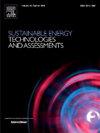Optimized hydrogen production through donor-assisted saline water splitting and its techno-economic feasibility
IF 7.1
2区 工程技术
Q1 ENERGY & FUELS
Sustainable Energy Technologies and Assessments
Pub Date : 2025-04-01
DOI:10.1016/j.seta.2025.104302
引用次数: 0
Abstract
This research explores the feasibility of producing green hydrogen through saline water electrolysis powered by renewable energy sources like solar photovoltaic. The study aims to minimize energy requirements by directly using seawater as an electrolyte, testing a 3 % NaCl concentration with varying hydrogen peroxide concentrations as a donor at different voltages and currents to optimize hydrogen production. Replacing platinum (Pt) electrodes with titanium-mixed metal oxide (Ti-MMo) electrodes in neutral media significantly reduces production costs. The optimal hydrogen evolution rate (HER) was achieved at 4 V using a 3 % NaCl and 1 % H2O2 solution, producing 80 ml/min of hydrogen at a current of 12 A. The levelized cost of hydrogen (LCOH) was evaluated using thermal and solar electricity costs of 0.095 USD/kWh and 0.024 USD/kWh, resulting in LCOH values of 9.87 USD/kg and 3.86 USD/kg, respectively. The findings highlight the potential of solar energy to reduce LCOH, making hydrogen production cleaner and more sustainable. The study encourages policymakers and investors to consider increased investment in this sector, as it could drive growth in the energy industry. Ultimately, while solar power significantly lowers LCOH, further advancements in solar panel technology are essential for ensuring long-term sustainability in green hydrogen production.

供体辅助盐水裂解制氢优化及其技术经济可行性
本研究探索以太阳能光伏等可再生能源为动力,通过盐水电解生产绿色氢的可行性。该研究旨在通过直接使用海水作为电解质来最小化能量需求,在不同电压和电流下测试3% NaCl浓度和不同过氧化氢浓度作为供体,以优化氢气产量。在中性介质中用钛混合金属氧化物(Ti-MMo)电极代替铂(Pt)电极可显著降低生产成本。在4 V条件下,以3% NaCl和1% H2O2溶液在12 a电流下产生80 ml/min的氢气,达到最佳析氢速率(HER)。采用0.095美元/千瓦时和0.024美元/千瓦时的光热和太阳能发电成本对氢的平准化成本(LCOH)进行了评估,得到的LCOH值分别为9.87美元/千克和3.86美元/千克。研究结果强调了太阳能在减少LCOH方面的潜力,使氢气生产更清洁、更可持续。该研究鼓励政策制定者和投资者考虑增加对该领域的投资,因为它可以推动能源行业的增长。最终,虽然太阳能发电显著降低了LCOH,但太阳能电池板技术的进一步进步对于确保绿色氢生产的长期可持续性至关重要。
本文章由计算机程序翻译,如有差异,请以英文原文为准。
求助全文
约1分钟内获得全文
求助全文
来源期刊

Sustainable Energy Technologies and Assessments
Energy-Renewable Energy, Sustainability and the Environment
CiteScore
12.70
自引率
12.50%
发文量
1091
期刊介绍:
Encouraging a transition to a sustainable energy future is imperative for our world. Technologies that enable this shift in various sectors like transportation, heating, and power systems are of utmost importance. Sustainable Energy Technologies and Assessments welcomes papers focusing on a range of aspects and levels of technological advancements in energy generation and utilization. The aim is to reduce the negative environmental impact associated with energy production and consumption, spanning from laboratory experiments to real-world applications in the commercial sector.
 求助内容:
求助内容: 应助结果提醒方式:
应助结果提醒方式:


